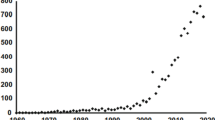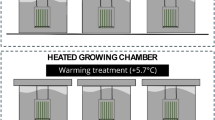Abstract
Bacterioplankton and total planktonic community respiration were measured in 14 Canadian lakes during the summer. Total planktonic community respiration (O2 consumption and CO2 production) was best predicted by total phosphorus (TP), with respiratory rates increasing at higher TP levels. The bacterioplankton respiration alone was less well linked to nutrient concentrations. Yet, the rates of both planktonic and bacterial CO2 production changed similarly with changes in the C:N ratio, with the bacterial fraction, on average, contributing about 42% of the total planktonic respiratory rates. Bacterial carbon respired was uncoupled from oxygen consumption, with resultant average planktonic respiratory quotient (RQ) close to 2. Bacterioplankton respiratory rates are affected by a negative relationship between specific aerobic respiration and bacterial biomass. Higher bacterial specific oxygen consumption rates (µg O2 cell-1 d-1) were observed with increasing C:N and C:P ratios, suggesting an increase in maintenance cost at the low cell densities observed in oligotrophic waters. Phosphorus appeared as the limiting nutrient in these lakes and determined total planktonic respiratory rates, however, epilimnetic bacterial respiration was mainly related to the DOC: nutrient ratios.
Similar content being viewed by others
References
Ahrens, M. A. & R. H. Peters, 1991. Plankton community respiration: relationships with size distribution and lake trophy. Hydrobiologia 224: 77–87.
APHA (Amer. Pub. Health Assoc.), 1989. Standard methods for the examination of water and waste-water. 17th ed. Washington, D.C.
Amon, R. M.W.& R. Benner, 1996. Bacterial utilization of different size classes of dissolved organic matter. Limnol. Oceanogr. 41: 41–51.
Azam, F., T. Fenchel, J. G. Field, J. S. Gray, L. A. Meyer-Reil & F. Thingstad, 1983. The ecological role of water-column microbes in the sea. Mar. Ecol. Prog. Ser. 10: 257–263.
Benner, R. & S. Opsahl & G. Chin-Leo, 1995. Bacterial carbon metabolism in the Amazon River system. Limnol. Oceanogr. 40: 1262–1270.
Biddanda, B., S. Opsahl & R. Benner, 1994. Plankton respiration and carbon flux through bacterioplankton on the Louisiana shelf. Limnol. Oceanogr. 39: 1259–1275.
Carlson, C. A. & H.W. Ducklow, 1996. Growth of bacterioplankton and consumption of dissolved organic carbon in the Sargasso Sea. Aquat. Microb. Ecol. 10: 69–85.
Carter, J. P., Y. H. Hsiao, S. Spiro & D. J. Richardson, 1995. Soil and sediment bacteria capable of aerobic nitrate respiration. Appl. envir. Microbiol. 61: 2852–2858.
Chrzanowski, T. H. & M. Kyle, 1996. Ratios of carbon, nitrogen and phosphorus in Pseudomonas fluorescens as a model for bacterial element ratios and nutrient regeneration. Aquat. Microb. Ecol. 10: 115–122.
Chrzanowski, T. H., R. W. Sterner & J. J. Elser, 1995. Nutrient enrichment and nutrient regeneration stimulate bacterioplankton growth. Microb. Ecol. 29: 221–230.
Coffin, R. B., J. P. Connolly & P. S. Harris, 1993. Availability of dissolved organic carbon to bacterioplankton examined by oxygen utilization. Mar. Ecol. Prog. Ser. 101: 9–22.
Cole, J. J., N. F. Caraco, G. W. Kling & T. K. Kratz, 1994. Carbon dioxide supersaturation in the surface waters of lakes. Science 265: 1568–1570.
Cole, J. J., S. Findlay & M. L. Pace, 1988. Bacterial production in fresh and saltwater ecosystems: a cross-system overview. Mar. Ecol. Prog. Ser. 43: 1–10.
Coveney, M. F. & R. G. Wetzel, 1995. Biomass, production and specific growth rate of bacterioplankton and coupling to phytoplankton in an oligotrophic lake. Limnol. Oceanogr. 40: 1187–1200.
Coveney, M. F. & R. G. Wetzel, 1992. Effects of nutrients on specific growth rate of bacterioplankton in oligotrophic lake water cultures. Appl. envir. Microbiol. 58: 150–156.
Currie, D. J., 1990. large-scale variability and interactions among phytoplankton, bacterioplankton and phosphorus. Limnol. Oceanogr. 35: 1437–1455.
Cuthbert, I. D. & P. del Giorgio, 1992. Toward a standard method of measuring color in freshwater. Limnol. Oceanogr. 37: 1319–1326.
Dawes, E. A., 1985. The effect of environmental oxygen concentration on the carbon metabolism of some aerobic bacteria. In I. S. Kulaev, E. A. Dawes & D.W. Tempest (eds), Environmental regulation of microbial metabolism. Academic.
del Giorgio, P., J. J. Cole & A. Cimbleris, 1997. Respiration rates in bacteria exceed phytoplankton production in unproductive aquatic systems. Nature 385: 148–151.
del Giorgio, P. & G. Scarborough, 1995. Increase in the proportion of metabolically active bacteria along gradients of enrichment in freshwater and marine plankton: implications for estimates of bacterial growth and production rates. J. Plankton Res. 17: 1905–1924.
del Giorgio, P. & R. H. Peters, 1994. Patterns in planktonic P: R ratios in lakes: influence of lake trophy and dissolved organic carbon. Limnol. Oceanogr 34: 772–787.
del Giorgio, P. & R. H. Peters, 1993. The influence of DOC on bacteria-chlorophyll relationship in lakes. Verh. int. Ver. Limnol. 25: 359–362.
Drabkova, V. G., 1990. Bacterial production and respiration in lakes of different types. Arch. Hydrobiol. Beih. 34: 209–214.
Elser, J. J., T. H. Chrzanowski, R. W. Sterner, J. H. Schampel & D. K. Foster, 1995. Elemental ratios and the uptake and release of nutrients by phytoplankton and bacteria in three lakes of the Canadian shield. Microb. Ecol. 29: 145–162.
Fenchel, T. & T. H. Blackburn, 1979. Bacteria and mineral cycling: 79–100. Academic.
Fenchel, T. & B. B. Jørgensen, 1977. Detritus food chains of aquatic ecosystems: the role of bacteria. Adv. Microb. Ecol. 1: 1–58. Academic.
Ferguson, R. L., E. N. Buckley & A. V. Palumbo, 1984. Response of marine bacterio-plankton to differential filtration and confinement. Appl. envir. Microbiol. 47: 49–55.
Goldman, J. C., D. A. Caron & M. R. Dennett, 1987. Regulation of gross growth efficiency and ammonium regeneration in bacteria by substrate C:N ratio. Limnol. Oceanogr. 32: 1239–1252.
Griesbach, S. J. & R. H. Peters, 1991. The effects of analytical variations on estimates of phosphorus concentration in surface waters. Lake Res. Mgmt 7: 97–106.
Hecky, R. E. & P. Kilham, 1988. Nutrient limitation of phytoplankton in freshwater and marine environments: a review of recent evidence on the effects of enrichment. Limnol. Oceanogr. 33: 796–822.
Hessen, D. O., T. Andersen & A. Lyche, 1990. Carbon metabolism in a humic lake: pool sizes and cycling through zooplankton. Limnol. Oceanogr. 35: 84–99.
Hobbie, J. E., 1992. Microbial control of dissolved organic carbon in lakes: research for the future. Hydrobiologia 229: 169–180.
Jahnke, R. A. & D. B. Craven, 1995. Quantifying the role of heterotrophic bacteria in the carbon cycle: a need for respiration rate measurements. Limnol. Oceanogr. 40: 436–441.
Kaplan, L. A., 1992. Comparison of high-temperature and persulfate oxidation methods for determination of dissolved organic carbon in freshwaters. Limnol. Oceanogr. 37: 1119–1125.
Kirchman, D. L., Y. Suzuki, C. Garside & H. W. Ducklow, 1991. High turnover rates of dissolved organic carbon during a spring phytoplankton bloom. Nature 352: 612–614.
Kristiansen, K., H. Nielsen, B. Riemann & J. A. Fuhrman, 1992. Growth efficiencies of freshwater bacterioplankton. Microb. Ecol. 24: 145–160.
Kuparinen, J. & A. Heinänen, 1993. Inorganic nutrient and carbon controlled bacterio-plankton growth in the Baltic Sea. Estuar. Coast. Shelf Sci. 37: 271–285.
Lampert, W., 1978. Release of dissolved organic carbon by grazing zooplankton. Limnol. Oceanogr. 23: 831–834.
Lean, D. R., 1973. Movements of phosphorus between its biologically important forms in lake water. J. Fish Res. Bd Can. 30: 1525–1536.
Linley, E. A. S. & R. C. Newell, 1984. Estimates of bacterial growth yields based on plant detritus. Bull. mar. Sci. 35: 409–425.
McAulife, C., 1971. G.C. determination of solutes bymultiple phase equilibration. Chem. Tech. 1: 46–51.
Neidhardt, F. C., J. L. Ingraham & M. Schaechter, 1990. Physiology of the bacterial cell — A molecular approach. Sinauer assoc, 506 pp.
Paerl, H. W., 1993. Interaction of nitrogen and carbon cycles in the marine environment. In T. E. Ford (ed.), Aquatic microbiology: an ecological approach: 343–381. Blackwell.
Peters, R. H. & M. Bergmann, 1982. A comparison of different phosphorus fractions as predictors of particulate pigment levels in Lake Memphremagog and its tributaries. Can. J. Fish aquat. Sci. 39: 785–790.
Pomeroy, L. R., 1974. The ocean's food web, a changing paradigm. Bioscience 24: 499–504.
Pomeroy, L. R., J. E. Sheldon, W. M. Sheldon Jr. & F. Peters, 1995. Limits to growth and respiration of of bacterioplankton in the Gulf of Mexico. Mar. Ecol. Prog. Ser. 117: 259–268.
Pomeroy, L. R., J. E. Sheldon & W. M. Sheldon Jr., 1994. Changes in bacterial numbers and leucine assimilation during estimations of microbial respiratory rates in seawater by the precision winkler method. Appl. Envir. Microbiol. 60: 328–332.
Pomeroy, L. R. & W. J. Wiebe, 1988. Energetics of microbial food webs. Hydrobiologia 159: 7–18.
Porter, K. G. & Y. S. Feig, 1980. The use of DAPI for identifying and counting aquatic microflora. Limnol. Oceanogr. 25: 943–948.
Prairie, Y. T., 1990. A comment on ‘nutrient status and nutrient competition of phyto-plankton in a shallow, hypertrophic lake'. Limnol. Oceanogr. 35: 778–779.
Rasmussen, J. B., L. Godbout & M. Schallenberg, 1989. The humic content of lake water and its relationship to watershed and lake morphometry. Limnol. Oceanogr. 34: 1336–1343.
Rudd, J. W. M., 1975. Dissolved methane. In M. P. Stainton et al. (eds), The chemical analysis of fresh water. 2nd ed. Fish. Res. Bd Can. Misc. Spec. Publ. No. 25: 22–26.
SAS (Statistical Analysis System), 1987. Procedures Guide for personal computers — Version 6 edition. SAS Institute Inc., NC, USA.
Scavia, D., 1988. On the role of bacteria in secondary production. Limnol. Oceanogr. 33: 1220–1224.
Schallenberg, M. & J. Kalff, 1993. The ecology of sediment bacteria in lakes and comparisons with other aquatic ecosystems. Ecology 74: 919–934.
Schindler, D.W., S. E. Bayley, P. J. Curtis, B. R. Parker, M. P. Stainton & C. A. Kelly, 1992. Natural and man-caused factors affecting the abundance and cycling of dissolved organic substances in pre-cambrian shield lakes. Hydrobioliologia 229: 1–21.
Schwaerter, S., M. Søndergaard, B. Riemann & L. M. Jensen, 1988. Respiration in eutrophic lakes: the contribution of the bacterioplankton and bacterial growth yield. J. Plankton Res. 10: 515–531.
Schweitzer, B. & M. Simon, 1995. Growth limitation of planktonic bacteria in a large mesotrophic lake. Microb. Ecol. 30: 89–104.
Sherr, B. F., E. B. Sherr & C. S. Hopkinson, 1988. Trophic interactions within pelagic microbial communities: Indications of feedback regulation of carbon flow. Hydrobiologia 159: 19–26.
Sokal, R. R. & F. J. Rohlf, 1995. Biometry: the principles and practice of statistics in biological research. 3d ed. W.H. Freeman and Company, 887 pp.
Søndergaard, M. & M. Middelboe, 1995. A cross-system analysis of labile dissolved organic carbon. Mar. Ecol. Prog. Ser. 118: 283–294.
Søndergaard, M. & N. H. Borch, 1992. Decomposition of dissolved organic carbon (DOC) in lakes. Arch. Hydrobiol. Beih. 37: 9–20.
Straskrabová, V., 1993. Respiration to synthesis ratio in microbial assemblages: relation to population density and growth. In R. Guerrero & C. Pedròs-Aliòs (eds), Trends in microbial ecology: 415–420. Spanish Society for Microbiology.
Sundh, I., 1992. Biochemical composition of dissolved organic carbon released from natural communities of lake phytoplankton. Arch. Hydrobiol. 125: 347–369.
SYSTAT, 1990. SYSTAT: The System for Statistics. SYSTAT Inc., Evanston, IL.
Tempest, D. W. & O. M. Neijssel, 1980. Growth yield values in relation to respiration. In C. J. Knowles (ed.), The diversity of bacterial respiratory systems., Vol. I, Chapter 1: 2–31. CRC Press.
Toolan, T., J. D. Wehr & S. Findlay, 1991. Inorganic phosphorus stimulation of bacterioplankton production in a meso-eutrophic lake. Appl. envir. Microbiol. 55: 1605–1611.
Tranvik, L. J., 1990. Bacterioplankton growth on fractions of dissolved organic carbon of different molecular weights from humic and clear waters. Appl. envir. Microbiol. 56: 1672–1677.
Tranvik, L. J., 1988. Availability of dissolved organic carbon for planktonic bacteria in oligotrophic lakes of differing humic content. Microb. Ecol. 16: 311–322.
Wetzel, R. G., 1992. Gradient-dominated ecosystems: sources and regulatory functions of dissolved organic matter in freshwater ecosystems. Hydrobiologia 229: 181–198.
Zar, J. H., 1984. Biostatistical analysis. Prentice-Hall, 718 pp.
Author information
Authors and Affiliations
Rights and permissions
About this article
Cite this article
Cimbleris, A.C.P., Kalff, J. Planktonic bacterial respiration as a function of C:N:P ratios across temperate lakes. Hydrobiologia 384, 89–100 (1998). https://doi.org/10.1023/A:1003496815969
Issue Date:
DOI: https://doi.org/10.1023/A:1003496815969




